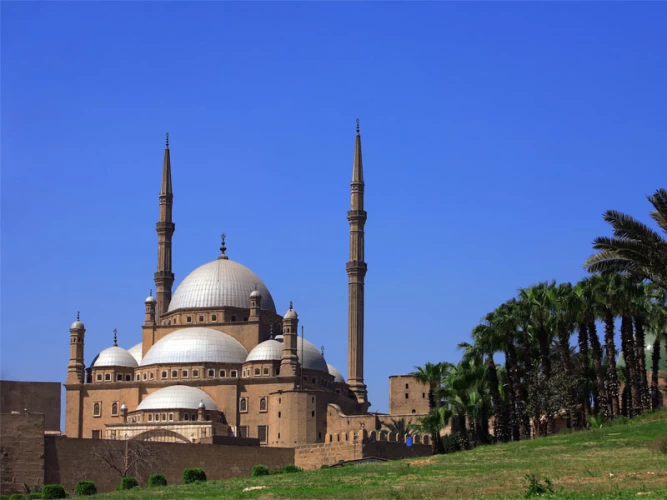
História do Egito | História do Egito Linha do Tempo
História do Egito
Devido à cheia do rio Nilo e suas margens férteis e deltas, assim como as realizações e o impacto dos povos indígenas egípcios, a história do Egito está repleta de grandes eventos e grandes eventos arqueológicos.
História do Egito Linha do Tempo
A maior parte da história antiga do Egito permaneceu um mistério até que a Pedra de Roseta foi descoberta e ajudou a decodificar os antigos segredos hieróglifos egípcios. A Grande Pirâmide de Gizé é uma das Sete Maravilhas do Mundo Antigo, e a Biblioteca de Alexandria tem sido a única de seu tipo durante séculos.
O Egito tem uma longa e gloriosa história, tornando-o uma das civilizações mais ilustres do mundo. A fundação humana no Egito data de pelo menos 6000 a.C. durante o Vale do Rio Nilo foi habitada pela primeira vez. A antiga civilização egípcia uniu por volta de 3150 AC com a unificação política do Alto e Baixo Egito sob o primeiro faraó da Primeira Dinastia, Narmer. O domínio egípcio original continuou em sua maior parte até a conquista do Império Aquemênida no século VI aC.
Pré-história (pré-3100 a.C.)
Há dados de petróglifos ao longo dos terraços do Nilo e em oásis do deserto. No ano 10 AC, uma cultura de caçadores-colectores e pescadores foi renovada por uma cultura de moagem de grãos. As mudanças climáticas e/ou o sobrepastoreio nas proximidades de 6000 AC começaram a dessecar as terras pastoris do Egito, formando o Saara. Os primeiros povos tribais migraram para o rio Nilo, onde formaram uma economia agrícola estabelecida e uma comunidade mais centralizada.
Por volta de 6000 a.C., uma cultura neolítica enraizada no Vale do Nilo. Durante a era Neolítica, várias culturas pré-dinásticas se desenvolveram independentemente no Alto e Baixo Egito. A cultura Badari e a série sucessora Naqada são geralmente consideradas como precursoras do Egito Dinástico. O mais antigo local conhecido do Baixo Egito, Merimda, é anterior ao Badari há cerca de setecentos anos. As comunidades contemporâneas do Baixo Egito coexistiram com suas congêneres do sul por mais de dois mil anos, permanecendo culturalmente distintas, mas mantendo contato freqüente através do comércio. As primeiras provas conhecidas de inscrições hieroglíficas egípcias apareceram durante o período pré-dinástico em vasos de cerâmica Naqada III, datados de cerca de 3200 a.C.
Antigo Egito (3100-332 a.C.)
Um reino unificado foi fundado em 3150 aC pelo rei Menes, levando a uma série de dinastias que governaram o Egito durante os três milênios seguintes. A cultura egípcia floresceu durante este longo período e permaneceu distintamente egípcia em sua religião, artes, língua e costumes. As duas primeiras dinastias governantes de um Egito unificado prepararam o cenário para o período do Velho Reino (c. 2700-2200 aC), que construiu muitas pirâmides, mais notadamente a pirâmide da Terceira Dinastia de Djoser e a Quarta Dinastia das Pirâmides de Gizé.
O primeiro período intermediário começou em uma época de turbulência política há quase 150 anos. A estabilidade do governo restaurou a prosperidade do país no Reino Médio em 2040 a.C. e atingiu seu clímax durante o reinado do Faraó Amenemhat o Terceiro. E com a entrada no segundo período de separação, com a chegada da primeira dinastia estrangeira no Egito, o reino Semitic Hexus. Os invasores Hyksos ocuparam a maior parte do Baixo Egito por volta de 1650 AC e criaram uma nova capital em Alvarez. Eles foram expulsos pela Força do Alto Egito liderada por Ahmose I, que fundou a Décima Oitava Dinastia e transferiu a capital de Memphis para Tebas.
O estado moderno (cerca de 1550 - 1070 AC) começou com a Décima Oitava Dinastia, indicando a ascensão do Egito como uma potência mundial que se expandiu durante sua maior extensão para um império tão ao sul quanto Tumbas em Núbia, e incluiu partes do Levante no leste. Este período foi indicado para alguns dos faraós mais famosos, incluindo Hatshepsut, Tuthmosis o Terceiro, Akhenaten e sua esposa Nefertiti e Tutankhamun, e Ramesses II. A primeira expressão historicamente aclamada de monoteísmo veio durante este período como Atenismo, embora alguns considerem o Atenismo uma forma de monoteísmo e não de monoteísmo. Os repetidos contatos com outros países trouxeram novas idéias para o novo reino. O país foi mais tarde invadido e ocupado pelos líbios, os líbios e os assírios, mas os egípcios indígenas acabaram por expulsá-los e retomar o controle de seu país.
Em 332 AC, o governante macedônio Alexandre o Grande conquistou o Egito quando derrubou os Aquemenidas e estabeleceu o Reino Ptolomaico Helenístico, cujo primeiro governante foi um dos antigos generais de Alexandre, Ptolomeu I Soter. Os Ptolomeu tiveram que lutar contra rebeliões nativas e estiveram envolvidos em guerras estrangeiras e civis que levaram ao declínio do reino e sua anexação final por Roma. A morte de Cleópatra pôs fim à independência nominal do Egito, resultando em que o Egito se tornasse uma das províncias do Império Romano.
O domínio romano no Egito (Período Romano-Bizantino) durou de 30 a.C. a 641 d.C., com um breve interlúdio de controle pelo Império Sasaniano entre 619-629, conhecido como Egito Sasaniano. Após a conquista muçulmana do Egito, partes do Egito se tornaram províncias de sucessivos califados e outras dinastias muçulmanas: Califado Rashidun (632-661), Califado Umayyad (661-750), Califado Abbasid (750-935), Califado Fatimid (909-1171), Sultanato Ayyubid (1171-1260) e o Sultanato Mamluk (1250-1517). Em 1517, o sultão otomano Selim I capturou o Cairo, absorvendo o Egito no Império Otomano.
O Egito permaneceu completamente otomano até 1867, sem durante o controle francês de 1798 a 1801. Inaugurado em 1867, o Egito tornou-se um país tributário auto-sustentável chamado Khedifa Misr. Mas, Khadift Egito caiu sob a administração britânica em 1882, na esteira da Guerra Anglo-Egípcia (Protetorado-Monarquia). Após o fim da Primeira Guerra Mundial e após a revolução egípcia em 1919, o Reino do Egito (República) foi estabelecido. Enquanto o Reino Unido é um estado independente de jure, ele mantém o controle sobre assuntos estrangeiros, defesa e outros assuntos. A ocupação britânica continuou até 1954, com a aprovação do Anglo-Egípcio em 1954.
Com a retirada completa das forças britânicas do Canal de Suez em 1956 DC, a moderna República do Egito foi fundada em 1953 DC, esta foi a primeira vez em 2500 anos que o Egito foi completamente independente e governado pelos egípcios originais. O Presidente Gamal Abdel Nasser (Presidente Ali Egito de 1956 a 1970) introduziu várias reformas e estabeleceu a efêmera República Árabe Unida com a Síria. Seus termos também assistiram à Guerra dos Seis Dias e à criação do Movimento Internacional dos Não-Alinhados. Seu sucessor Anwar Sadat (presidente de 1970 a 1981) mudou o curso do Egito, afastando-se de muitos princípios políticos e econômicos de Nasiriyah, restabelecendo um sistema multipartidário e lançando a política de abertura econômica. Ele conduziu o Egito na Guerra do Yom Kippur de 1973 para restaurar a Península do Sinai no Egito, que Israel ocupava desde a Guerra dos Seis Dias em 1967. Isto posteriormente levou ao tratado de paz entre o Egito e Israel.
A história recente do Egito foi dominada por eventos após quase trinta anos de governo do ex-presidente Hosni Mubarak. A revolução egípcia de 2011 depôs Mubarak e resultou no primeiro presidente democraticamente eleito da história egípcia, a agitação após a revolução de 2011 e as disputas relacionadas levaram ao golpe de Estado egípcio de 2013.
as atracções no Egipto podem ser feitas durante um dos tours Passeios De Luxo No Egito que lhe permite ficar nos hotéis e cruzeiros do Nilo mais notáveis ou se estiver a viajar com uma pequena quantia de dinheiro e gostaria de poupar o seu tempo e despesas pode verificar a nossa grande variedade de pacotes de tours Passeios De Luxo No Egito baratos, se tiver estado num acidente e sofrer de um ferimento físico nunca se preocupe porque os nossos operadores profissionais personalizaram uma colecção de pacotes de tours Egypt acessíveis em cadeira de rodas que utilizam todos os veículos acessíveis e diferentes instalações para pessoas deficientes, que é uma das principais categorias dos nossos tours Passeios Clássicos Do Egito.
Um especialista da Cairo Top Tours, especializado em Egiptologia e falando a sua língua, irá ajudá-lo onde for necessário.
The ancient history that can be perceived from the Pharaohs has to be one of the greatest historical civilizations ever. Its events’ timeline is well over five thousand years, and many aspects of the world, such as art, architecture, culture, and even religion, have their bases in Egypt. The records of the land of Egypt are interesting in that they contain histories of empires that were built and then perished, histories of great kings and queens, and outstanding places and structures that even today, in modern societies, can only marvel at. Egypt’s history is undoubtedly dominated by a vibrant narrative of struggle, hope, and ingenuity of the people portrayed, from the making of the pyramids to the currents of the Nile.
The Ancient Kingdoms of Egypt (c. 3100 BC–332 BC)
1. Pre-Dynastic Period (Before 3100 BC)
The elements of history written of Egypt are dated around 3100 BC, but if one avails of its importance in terms of history, it dates back even to the pre-dynastic era, when there was the emergence of small agricultural settlements along the Nile. By this time, the early residents of Egypt were busy establishing forms of agriculture as well as animal husbandry, pottery making, and the making of crude tools. These settlements served as the foundation of the elaborate systems of culture and society that were to come.
2. The Unification and Early Dynastic Period (c. 3100–2686 BC)
King Narmer, often referred to as Menes was responsible for the unification of Upper and Lower Egypt, which signified the onset of ancient Egyptian civilization. He is considered to be the first pharaoh of Egypt and founded the nation’s first dynasty. This unifying act was essential since it created the nucleus around which the centralized monarchy of Egypt, which was the prevailing system of government for almost three thousand years, would revolve.
Towards the tail end of the Early Dynastic, the very first steps in the construction of monumental architecture began, and hieroglyphs were mastered. It was in this period that the rulers were expected to fulfill the role of the king and also that of a god. This idea existed for many years and was a fundamental one in Egypt.
3. The Old Kingdom (c. 2686–2181 BC)
The divine rulers, who were the Pharaohs in the earthly realm, tamed every resource and manpower to erect huge structures such as the Great Pyramid of Khufu and the Sphinx.
The Old Kingdom period displayed a clear and consistent administrative hierarchy and even a large-scale institutional support system that controlled the resources, agricultural production, and the temples of the state. However, in the latter years of this era, the dominant position of the central authority began to diminish, ushering in an era of chaos and fragmentation.
4. The Middle Kingdom (c. 2055–1650 BC)
Following the tumultuous First Intermediate Period referred to, Egypt returned to political stability and strong rulers in its Middle Kingdom. There is a revival in this period in the fields of art, literature, and monumental building works. Pharaohs such as Mentuhotep 11 and Senusret 111 were responsible for extending Egypt’s boundaries southward into Nubia as well as promoting relations with other countries through trade.
The Middle Kingdom is usually regarded as the classical period of ancient Egypt, filled with relative calm and wealth. The authorities emphasized the development of construction and the growth of the economy of Egypt. In spite of such achievements, the internal conflicts and external challenges finally caused the disintegration of the Middle Kingdom, making way for another period of darkness and despair.
5. The New Kingdom (c. 1550–1070 BC)
The new kingdom constitutes, also from a chronological point of view, the culminating era of ancient Egyptian civilization. It was during this period that Egypt was transformed into a full-fledged empire under rulers such as Thutmose III, Hatusu, and Rameses II, who through wars and conquests, or rather political strategies, expanded Egypt's borders. He also added great temples during this period, such as those at Karnak, Luxor, and Abu Simbel, many of which still exist today.
Il nuovo regno era un’epoca che riformò anche la religione in notevoli modi, come il periodo di regno del faraone Akhenaten, which introduced a period of continuous fight in worshipping a single god—Aten, the disk of the sun. His was, however, an unpopular and a very brief rule, for there were leaders after him who brought back the old ways of worship in Egypt, which was worshiping none but many gods.
But then, power aside, Egypt was not immune to the laws of history. By the close of the New Kingdom, this state institution in question was already wobbly, and there was a gradual abatement of its activities.
1. The Ptolemaic Dynasty (332–30 BC)
For many centuries, the old state of Egypt thrived free until that point in time, which altered when the rule of Alexander the Great started in the year 332 BC. It was also during those years that Alexandria became the center of Greek civilization and education, with the noted Library of Alexandria and the Lighthouse, which is now one of the Seven Wonders of the Ancient World.
Until the end of the dynasty, the traditions of Egypt were largely maintained, even though the rulers were Hellenistic kings. The last ruler of this dynasty, Cleopatra VII, was known to have opposed the domination of Rome by trying to establish relations with Julius Caesar and Mark Antony. However, after her loss at the Battle of Actium in 31 BC, Egypt fell into the Roman Empire.
Under the control of the Romans, Egypt was considered one of the most valuable provinces of the empire, primarily because it was rich and produced plenty of crops, particularly grains. The Romans maintained several of the practices of the Ptolemaic kings; however, Egypt was administered as a colony of the empire. The establishment of Christianity in Egypt started during the Roman times, and it was in the 4th century A.D. that Egypt began to develop into a significant early center of Christianity.
The phase change from the Roman to the Byzantine Empire that occurred in 395 AD marked the slow deterioration of Egypt’s economic well-being, but Egypt was still geographically and religiously active. It was also in this time period that the popular Coptic Church was born, which incorporated aspects of Christianity with ancient Egyptian beliefs.
The Egyptian territories fell to the Army of Islam in the year 642 AD. This marked the commencement of the Islamic Era in Egypt. As Cairo, a city created by the Fatimids in 969 AD, grew prominent, it was clear that Egypt was going to become one of the most pivotal countries in the Islamic world. After most of the Egyptian lands were conquered, Egypt witnessed great prosperity in learning, trade, and the arts.
The Fatimids, Ayyubids, and Mamluks
The capital of Egypt was established, and the famous Al-Azhar University was built during the reign of the Fatimid Dynasty which ruled over Egypt. With the waning of the Fatimid era, Egypt was captured for a brief period by the fact that Saladin, protector of the territories, including Egypt himself, later founded the Ayyubid dynasty, whose main task was fighting against the Crusaders.
Later came the Mamluks, who were a military caste and who ruled over Egypt for several eras. They built a number of the most beautiful structures in the city, including mosques, schools, and fortifications, in the Mamluk period. Egypt was, at least at the stage when it was defeated, a rather big country with advanced development before it was conquered by the Ottoman Empire.
Egypt in the Modern Era (1517–Present)
1. Ottoman and British Rule
With the Ottoman Empire's conquest in 1517, Egypt was annexed as part of the empire for nearly four hundred years and had remained so bound. That is primarily due to its geopolitical possibilities; it was invaded several times by European powers, and in 1798 Napoleon Bonaparte managed to invade Egypt for a short period. After the French lost in this region, Egypt was ruled by Muhammad Ali Pasha, who was on modern Egypt’s compass. He reformed agriculture, industry, and the military; these transformations served as the waking up of the modern state of Egypt.
In the late nineteenth century, Egypt acquired the status of a British protectorate, which lasted until ’52, the year Egypt resumed control after a revolution led by Gamal Abdel Nasser. It was Nasser who became one of the most powerful figures within the Arab sphere of influence, propagating pan-Arabism and earlier nationalizing the Suez Canal in 1956.


















